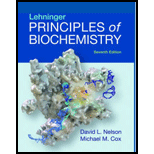
Concept explainers
(a)
To determine: The slowest migrating polypeptide among the three given polypeptides in an ion-exchange chromatography having resin beads coated with positively charged groups.
Introduction:
In ion-exchange chromatography, polar molecules or ions are separated on the basis of their affinity to ion exchanger. Proteins, amino acids, and small
(b)
To determine: The slowest migrating polypeptide among the three given polypeptides in an ion-exchange chromatography having resin beads coated with negatively charged groups.
Introduction:
In ion-exchange chromatography, polar molecules or ions are separated on the basis of their affinity to ion exchanger. Proteins, amino acids, and small nucleotides can be seprated with the help of ion exchange chromatography. Ion exchange chromatography is of two types; cation-exchange chromatography and anion-exchange chromatography. Cation-exchange chromatography is used for the separation of positively charged molecules.
(c)
To determine: The slowest migrating polypeptide among the three given polypeptides in a size-exclusion chromatography column designed to separate small peptides.
Introduction:
Size-exclusion chromatography is also termed as molecular sieve chromatography. In this procedure, the molecules are separated according to their size and molecular weight. Size-exclusion chromatography is basically used for macromolecules such as proteins.
(d)
To determine: The peptide that contains ATP-binding motif shown in the given sequence logo.
Introduction:
ATP (adenosine triphosphate) is a complex organic compound that cell produces during the process of
Want to see the full answer?
Check out a sample textbook solution
Chapter 3 Solutions
Lehninger Principles of Biochemistry
 BiochemistryBiochemistryISBN:9781319114671Author:Lubert Stryer, Jeremy M. Berg, John L. Tymoczko, Gregory J. Gatto Jr.Publisher:W. H. Freeman
BiochemistryBiochemistryISBN:9781319114671Author:Lubert Stryer, Jeremy M. Berg, John L. Tymoczko, Gregory J. Gatto Jr.Publisher:W. H. Freeman Lehninger Principles of BiochemistryBiochemistryISBN:9781464126116Author:David L. Nelson, Michael M. CoxPublisher:W. H. Freeman
Lehninger Principles of BiochemistryBiochemistryISBN:9781464126116Author:David L. Nelson, Michael M. CoxPublisher:W. H. Freeman Fundamentals of Biochemistry: Life at the Molecul...BiochemistryISBN:9781118918401Author:Donald Voet, Judith G. Voet, Charlotte W. PrattPublisher:WILEY
Fundamentals of Biochemistry: Life at the Molecul...BiochemistryISBN:9781118918401Author:Donald Voet, Judith G. Voet, Charlotte W. PrattPublisher:WILEY BiochemistryBiochemistryISBN:9781305961135Author:Mary K. Campbell, Shawn O. Farrell, Owen M. McDougalPublisher:Cengage Learning
BiochemistryBiochemistryISBN:9781305961135Author:Mary K. Campbell, Shawn O. Farrell, Owen M. McDougalPublisher:Cengage Learning BiochemistryBiochemistryISBN:9781305577206Author:Reginald H. Garrett, Charles M. GrishamPublisher:Cengage Learning
BiochemistryBiochemistryISBN:9781305577206Author:Reginald H. Garrett, Charles M. GrishamPublisher:Cengage Learning Fundamentals of General, Organic, and Biological ...BiochemistryISBN:9780134015187Author:John E. McMurry, David S. Ballantine, Carl A. Hoeger, Virginia E. PetersonPublisher:PEARSON
Fundamentals of General, Organic, and Biological ...BiochemistryISBN:9780134015187Author:John E. McMurry, David S. Ballantine, Carl A. Hoeger, Virginia E. PetersonPublisher:PEARSON





